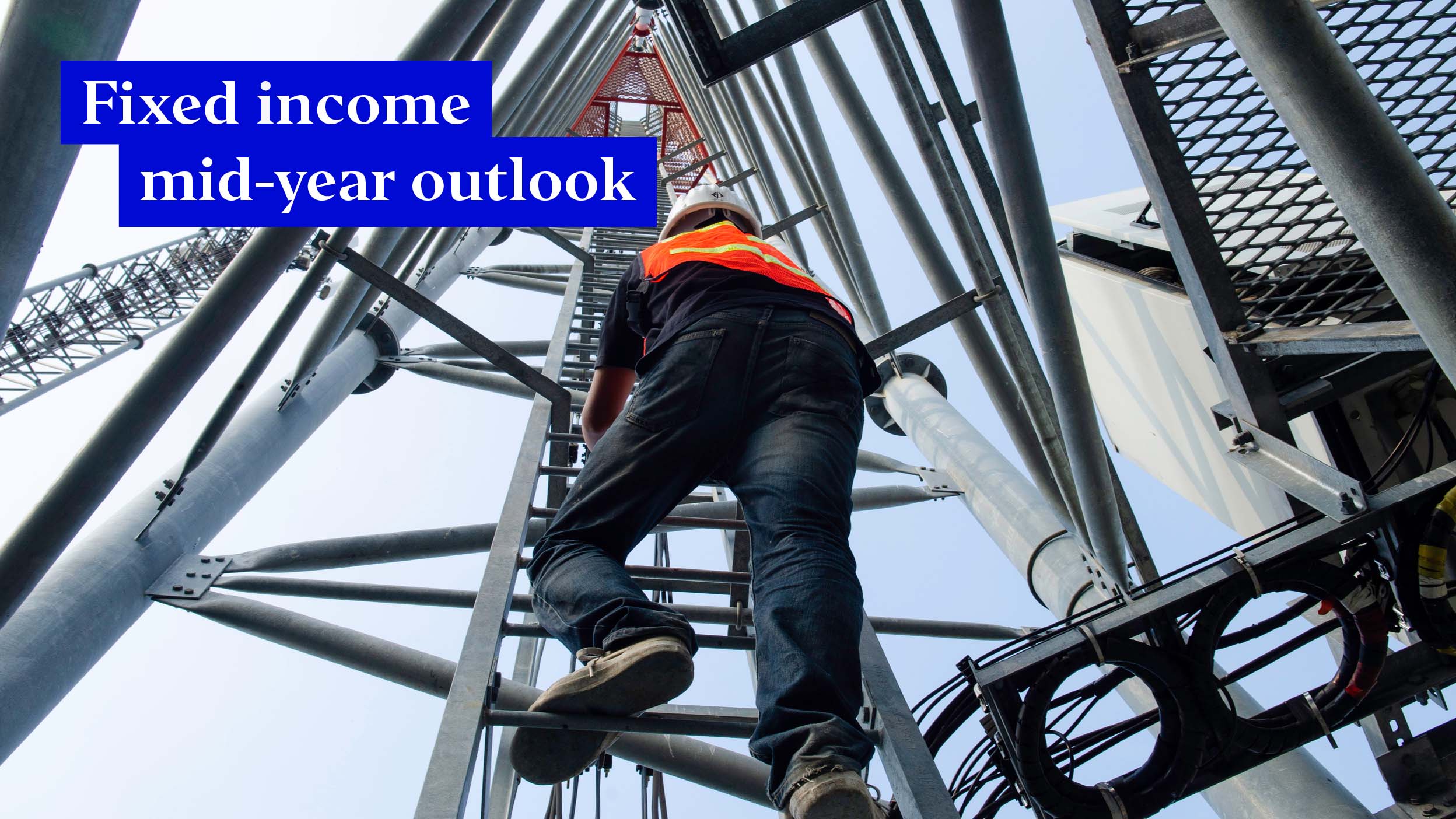
European equities
Read on to see what our European equities team think.

You’ve heard what they say about yesterday’s news. But, in a year where a lot has changed in a very short period, what should we make of December’s outlooks?
War, energy shocks and ‘apocalyptic’ inflation – things have escalated a lot since year-end. But what impact have these crises had on equity markets, and did our views materialise? We share our thoughts.

European equities
Read on to see what our European equities team think.
We were optimistic on Europe at the start of the year. Despite the headlines, we remain so, given attractive valuations in many segments of the market alongside particularly pessimistic sentiment. Returns are typically greatest as markets climb walls of worry.
There’s strong evidence that we’re in a markedly different environment today compared to post-global financial crisis (GFC) and during COVID. Portfolios need to acknowledge these changes. But we believe, this is still a good opportunity for the longer-term investor, despite the near-term growth challenges because of China lockdowns and the Russia/Ukraine conflict. Of the three trends we previously outlined for 2022, the direction of travel remains supportive.
Another crisis, this time the war in Ukraine, has highlighted the need for Europe to become less dependent on others for energy and other goods. This should accelerate the transition to renewables.
It’s another reason why we believe regionalisation, and not globalisation, is likely to be a dominant driver for many years to come. These themes, as well as higher defence spending, will require significant investment from both companies and governments, supporting growth in the cyclical parts of the market.
As it became clear inflation wasn’t transitory, central banks began hiking interest rates. Shorter term, markets are grappling with what this could mean for economic growth. For those with a medium-term horizon, the outlook for inflation and growth is quite different to the previous decade, when disinflation and stagnant growth were the norm. We believe the focus remains shorter duration equities vs the Growth/Quality darlings of the past decade.
Quarter one earnings are on track to grow by over 20% year on year (YoY)1. From here, this rate of growth will slow. But we believe the market looks to have priced in a mild slowdown in many of the cyclical parts of the market. We believe valuations are compelling and in our view, there are opportunities here, especially with the near-term lifting of lockdowns in China.

UK equities
Neville Pike, Product Director for the UK equities team, shares his thoughts.
At the end of last year, we highlighted that inflation would put pressure on high value stocks, favouring shorter duration stocks in strategies with a fundamental approach to valuation. Within UK equities, we identified the opportunity to invest in a good range of long-term structural themes, like climate change and energy transition.
The terrible events in Ukraine have accelerated the pressures that were already evident to us:
These will continue to build over the rest of the year.
Year to date, equity markets have favoured shorter duration stocks in strategies with a fundamental approach to valuation, over high value stocks in momentum type-strategies. And, for the first sustained period since the referendum of 2016, UK equities have outperformed the US, continental Europe, and Japan.
As with everyone reading this note, we hope that lasting peace can soon be found in Ukraine. But the underlying pressures on inflation and on companies are unlikely to reverse any time soon.
Peace or a de-escalation may moderate energy prices, and year-on-year inflation is likely to have moved past its peak by the end of the year. However, the desire to accelerate energy transition and achieve greater self-sufficiency, and a general shift towards onshoring vs offshoring, will be with us for some time. In summary, the next ten years are going to look very different to the last ten.
Despite the outperformance of the UK year to date, we believe there is much more to come. The below chart looks at the valuation of global markets based on more than 2,000 observations over 20 years (each dot is a month in a market). It plots price-to-book (P/B) against return on equity (ROE). In other words, it recognises that:
Looking at the latest pricing of indices relative to the model valuation, the regression line indicates that the US has just under 10% downside (from ‘growth’ styles). But the UK – with its feet firmly grounded in ‘value’ – still has around 20% upside from here.
Source: Invesco, Factset as at 30 April 2022. Indices used: FTSE All-world, FTSE UK All-share, MSCI Europe ex-UK, FTSE Japan, MSCI Asia ex-Japan, S&P 500, MSCI US Growth, MSCI US Value. Plots show monthly Price to Book (P/B) ratio against monthly mean rolling 12month estimated Return on Equity (ROE), beginning 30 April 2002. The Implied P/B is the value derived from application of the algebraic equation of the trend line, substituting Current ROE for “x”.
| FTSE All-share | Europe ex-UK | S&P 500 | US Growth | US Value | |
| Current ROE | 14.5 | 13.0 | 21.2 | 30.1 | 18.5 |
| Current P/B | 1.7 | 1.8 | 3.7 | 9.0 | 2.6 |
| Implied P/B based on 20-yr regression | 2.0 | 1.8 | 3.4 | 6.7 | 2.7 |
| Difference | 21% | 0% | -9% | -17% | 6% |
Inevitably, there will be near-term volatility. But the bottom line is that the improved outlook for UK corporate earnings and for nominal growth should, in an undervalued market, boost the outlook for UK listed equities. Key beneficiaries will likely include high quality, cash generative businesses, which form a significant part of our portfolios.

Asian equities
Our Asian equities team share their view.
Markets are concerned about inflation, policy normalisation, the war in Ukraine and the resurgence of COVID in China – and rightly so. The uncertainty is causing a reassessment of equity risk premiums across asset classes.
But two years into the pandemic, it’s becoming endemic. This suggests that re-opening potential in China and the rest of Asia is about 12-24 months out. Inflation is less of a concern in Asia than in the US, suggesting greater policy flexibility, which should also be supportive for markets.
The valuation of Asian equity markets has dropped markedly over the last 12 months from 2x price/book to today’s 1.5x2. Buying the market at these valuation levels has historically led to decent returns on a 3-5-year view, despite a likely downgrade in consensus earnings growth estimates for 2022. This is leading to heightened volatility, which we view as favourable for stock pickers.
The recent weakness in markets has been particularly acute in those parts driven by sentiment, like the non-profitable technology, healthcare and electric-vehicle related sectors. We believe these areas are overvalued and have therefore avoided them.
In line with our investment approach, we invest in undervalued companies, and this has led us to be relatively well positioned for the latest rotation from growth to value stocks. As the economic recovery continues, cyclical parts of the markets have done relatively better.
We continue to find undervaluation opportunities in China which is now trading close to 11x forward price to earnings ratio (P/E) and 1.3x trailing book value2, both below long-term historical averages.
We currently favour Indonesia over India because of differences in valuations. We also believe that the Indonesian economy is likely to be more resilient in an environment of higher energy and commodity prices.

Equity exchange-traded funds
Chris Mellor, Head of EMEA ETF Equity & Commodity Product Management, gives us a rundown.
Following one of the strongest starts to a year, with more than $25 billion (around 85% of total net inflows)3 going into equity ETFs in January, the investment climate has turned more unsettled for obvious reasons. Many investors appear to be adopting either a risk-off stance within their portfolios or a ‘wait and see’ attitude, with question-marks over the path of economic growth and inflation.
It’s been evident for at least the past several years that investors are turning to ETFs irrespective of market conditions, although their choice of exposure can vary significantly. You could point to the way ETFs are traded, with enhanced liquidity and ability to buy and sell throughout the day being advantages in turbulent times.
While many investors are currently using ETFs to construct portfolios, either entirely or in combination with other types of vehicles, we could reasonably expect that other investors may be using them now to maintain market (beta) exposure, possibly with the view of eventually transitioning to actively managed funds.
We believe low-cost core beta ETFs are likely to continue playing meaningful roles in diversified portfolios and, based on recent flow data, we may reasonably expect further allocations to ETFs with environmental, social and governance (ESG) objectives. In the first four months of the year, the strongest trends have been into those ETFs with climate-specific objectives or that apply either a strict best-in-class approach or tilt weighting toward companies with stronger ESG characteristics.
We believe investors may also wish to consider deploying a portion of their risk budgets in thematic areas to capture potentially less correlated growth opportunities. Examples may include themes related to meeting environmental challenges or using disruptive technologies.
Disruptive technology also remains a strong theme, with blockchain continuing to provide companies in a range of industries the opportunity to improve efficiency and reduce costs.

While COVID-19’s remarkable effects on economies and policies remain top of mind, a new set of uncertainties has entered the picture.
14 June 2022

Against a backdrop of war, inflation and rate hikes, our fixed income experts comment on 2022 so far and share their outlook for the year ahead.
14 June 2022
1 Q1 earnings from Bloomberg as at 31 May 2022.
2 Bloomberg, 31 May 2022
3 Invesco and Bloomberg, Europe-domiciled ETPs, year to 29 April 2022.
The value of investments and any income will fluctuate (this may partly be the result of exchange rate fluctuations) and investors may not get back the full amount invested.
This is marketing material and not intended as a recommendation to buy or sell any particular asset class, security or strategy. Regulatory requirements that require impartiality of investment/investment strategy recommendations are therefore not applicable nor are any prohibitions to trade before publication.
Where individuals or the business have expressed opinions, they are based on current market conditions, they may differ from those of other investment professionals, they are subject to change without notice and are not to be construed as investment advice.